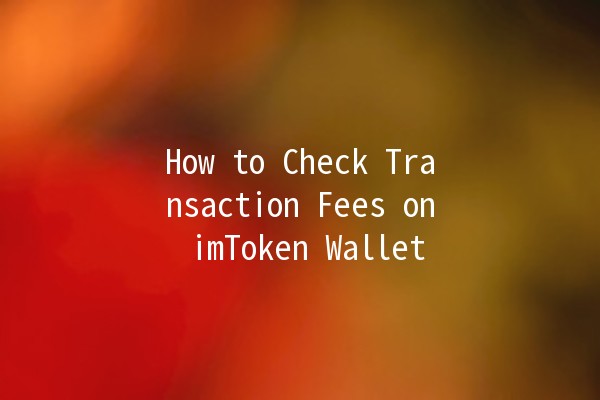When navigating the world of cryptocurrencies, one crucial aspect that users need to keep an eye on is transaction fees. With the rapid evolution of digital wallets, understanding how to check transaction fees can seem daunting, particularly for beginners. This article focuses on how to efficiently view transaction fees using the imToken wallet, a popular choice for managing various cryptocurrencies.
Transaction fees are a standard practice in almost all blockchain networks, serving multiple purposes; they prioritize transactions, compensate miners for their work, and protect the network from malicious actors. Here’s a brief overview:

What Are Transaction Fees?
Transaction fees are amounts users must pay to have their transactions processed on the blockchain. Each digital currency has its unique fee structure, which can fluctuate based on network congestion.
Why Are They Important?
Knowing transaction fees helps users plan their transactions more effectively, ensuring they spend just the right amount to expedite or secure processing according to their needs.
The imToken wallet supports various cryptocurrencies like Ethereum, Bitcoin, and many ERC20 tokens. Its userfriendly interface allows users to check and manage transaction fees with ease. Here’s how to view them effectively.
Before you can check transaction fees, you need to log into your imToken wallet.
Download the App: First, ensure you have the imToken app installed on your mobile device. It is available for both Android and iOS platforms.
Create or Import Wallet: Follow the prompts to create a new wallet or import an existing one using your private key or mnemonic phrase.
Once you have your wallet set up, it’s important to locate the transaction fees.
Select an Asset: Choose the cryptocurrency asset for which you wish to view transaction fees. This can be done from the wallet's homepage or the asset management section.
Initiate a Transaction: Click on the "Send" or "Transfer" option. You will then enter the amount and the recipient’s address.
After entering the relevant details, the imToken wallet will display the proposed transaction fee.
Fee Structure Visibility: The wallet typically shows fees in both the native currency (like ETH for Ethereum transactions) and as a fiat equivalent.
Adjusting Fees: In many cases, you can adjust the fee according to your urgency. More urgent transactions generally require higher fees to incentivize miners.
Understanding the current network condition can help you choose the right moment for your transaction.
Network Status Indicators: imToken may provide realtime insights about current network status and fee trends. This can be crucial for timing your transaction to avoid unreasonably high fees.
Using External Tools: For more detailed analysis, consider using external platforms like Gas Now or Eth Gas Station to understand Ethereum gas fees.
When confirming a transaction, always examine the complete cost.
Transaction : Before finalizing a transaction, the imToken wallet presents a summary, detailing the amount being sent, the transaction fee, and the total cost.
Comparative : Utilizing this summary avoids sudden surprises and helps you stay aware of ongoing costs.
Understanding and keeping an eye on transaction fees can significantly enhance your trading experience. Here are five productivityboosting tips for managing transaction costs:
Many platforms and apps provide fee estimators based on current network conditions. Using these tools can help you plan transactions better, ensuring you allocate the right amount for fees.
Regularly checking on network congestion can save you money. If the network is busy, it’s often worth waiting until traffic lightens to conduct your transactions.
Explore the option to customize transaction fees within the imToken wallet or any other wallet you use. Setting lower fees for less urgent transactions can be economical.
Consider setting up notifications or alerts to inform you about significant changes in transaction fees. This proactive approach ensures you're always informed and can act quickly during favorable conditions.
Reviewing past transactions helps users understand fee trends and common practices. This empirical insight can aid decisionmaking for future transactions.
Various factors affect transaction fees, including the network's current load, the complexity of the transaction, and recent market volatility. High network congestion can lead to higher fees as users bid for priority in transaction processing. Understanding these variables helps in timing your transactions effectively.
To lower transaction fees, you can choose to execute transactions during offpeak hours when network traffic is minimal. Furthermore, some wallets allow users to set a lower fee, albeit with longer processing times. This strategy helps save costs without sacrificing transaction integrity.
In general, transaction fees are inherent to blockchain technology and cannot be completely eliminated. However, some platforms and cryptocurrencies offer zerofee transactions under specific conditions, like loyalty programs or promotional events. Always check current offers before proceeding.
Transaction fees fluctuate frequently based on network activity and overall demand for the currency in question. Fees can change within seconds during high volatility, making it essential to stay updated or utilize tools that provide realtime data on current fee structures.
Yes, the imToken wallet displays transaction history along with applicable fees for each completed transaction. Accessing historical data enables users to analyze their past expenditure on fees and make informed decisions for future transactions.
If a transaction fee appears excessively high, you can choose to wait before confirming the transaction. By monitoring the network and utilizing fee estimators, you can wait for optimal conditions to confirm your transaction at a lower cost.
By following the above procedures and tips, users can navigate imToken's features with sufficient knowledge to make informed decisions regarding transaction fees. This understanding not only enhances your trading efficiency but also provides financial benefits by saving on unnecessary costs.